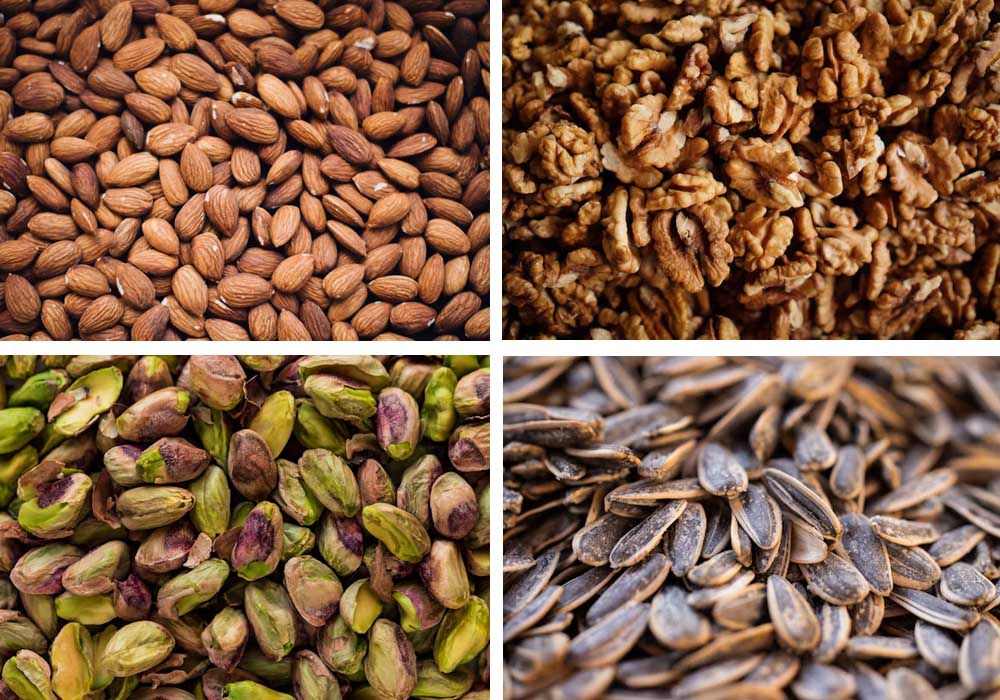Almond Sorting Machine
Walnut Sorting Machine
Cashew Sorting Machine
Pistachio Sorting Machine
Hazelnut Sorting Machine
Brazil Nut Sorting Machine
Pecan Sorting Machine
Macadamia Sorting Machine
Sunflower Seed Sorting Machine
Pumpkin Seed Sorting Machine
Sesame Seed Sorting Machine
Chia Seed Sorting Machine
Flaxseed Sorting Machine
Baru Nut Sorting Machine
Pine Nut Sorting Machine
Roasted Nut Sorting Machine
Blanched Nut Sorting Machine
Organic Seed Sorting Machine
Pili Nut Sorting Machine
What is Nuts and Seeds Sorting
Nuts and seeds sorting is a precision process that utilizes advanced color sorting technology to separate various types of nuts and seeds based on their color, size, and optical characteristics. This automated process ensures the removal of foreign materials, defective pieces, and discolored items, delivering premium quality products for both food manufacturers and consumers. The technology plays a crucial role in maintaining food safety standards and product consistency in the nut and seed processing industry.
Modern nut and seed sorting solutions handle a wide range of products including almonds, walnuts, pistachios, sunflower seeds, pumpkin seeds, and many more. These systems help processors achieve higher yields while reducing waste, enabling them to meet the growing global demand for quality nuts and seeds. Whether for retail packaging or industrial food production, optical sorting provides the accuracy and efficiency needed in today's competitive market.

How Nuts and Seeds Sorting Works
Nut and seed sorting machines employ high-resolution CCD cameras and near-infrared technology to inspect each individual piece as it passes through the system. The optical sensors capture detailed color and shape information, detecting even minor defects or color variations. When an undesirable piece is identified, the system activates precise air jets to remove it from the production line without affecting the flow of good product.
The sorting process begins with proper feeding and distribution of nuts/seeds onto the inspection belt. Advanced imaging systems analyze multiple aspects of each piece including color, shape, size, and even internal characteristics in some advanced models. Real-time processing allows for immediate ejection of defective items, foreign materials, or product with shell fragments. This technology achieves accuracy levels impossible with manual sorting methods.
Core Features and Benefits of Nuts and Seeds Sorting
Modern nut and seed sorting systems offer exceptional accuracy in defect detection, capable of identifying and removing pieces with color defects, mold, insect damage, or foreign materials. These machines process thousands of nuts/seeds per minute with remarkable consistency, significantly improving product quality while reducing labor requirements. The customizable nature of these systems allows processors to adjust sensitivity for different product types and quality standards.
Beyond quality improvement, these sorters enhance food safety by removing potential contaminants and allergens. They help processors maximize yield from raw materials while minimizing good product loss. The non-invasive nature of optical sorting preserves the nutritional value and integrity of the nuts and seeds throughout the process. Many systems now feature smart learning capabilities that continuously improve sorting accuracy based on the specific product characteristics.
Technical Specifications of Nut and Seed Sorting Machines
High-performance nut and seed sorters typically feature full-color CCD cameras with resolutions capable of detecting defects as small as 0.2mm. Processing capacities range from 500kg to 5 tons per hour depending on the machine model and product type, with ejection accuracy rates exceeding 99.5%. Many advanced models incorporate dual-camera systems or additional sensors like near-infrared (NIR) for more comprehensive inspection.
Modern sorters feature intuitive touchscreen interfaces for easy operation and recipe management. Robust construction using food-grade materials ensures durability in demanding processing environments. Energy-efficient designs minimize power consumption while delivering maximum sorting performance. Many models offer connectivity options for integration with factory automation systems and remote monitoring capabilities.
Applications of Nut and Seed Sorting Technology
Nut and seed sorting technology serves diverse applications across the food industry. It's essential for premium nut products where appearance directly impacts market value, such as whole almonds or shelled pistachios. The technology is equally valuable for seed processors who need to ensure purity and germination rates, and for manufacturers of nut-based products who require consistent raw material quality.
Beyond conventional applications, these sorters are increasingly used in organic product processing where chemical treatments aren't permitted. They play a vital role in producing nut flours and butters by removing potential contaminants before grinding. The technology also benefits the snack food industry by ensuring consistent quality in mixed nut products and trail mixes.
Buying Guide
When selecting a nut and seed sorting machine, consider the specific products you'll be processing and their typical defect profiles. The machine's throughput should match your production volume requirements, with some flexibility for peak periods. Pay attention to the machine's ability to handle different sizes and shapes if you process multiple product types. Food-grade construction and easy cleaning features are essential for maintaining hygiene standards.
Evaluate the machine's sorting accuracy claims through demonstrations using your actual product. Consider additional features like cloud connectivity for performance monitoring and recipe storage for different products. Availability of local technical support and spare parts should factor into your decision, along with the manufacturer's reputation in the nut and seed processing industry.
Maintenance Guide
Regular maintenance ensures optimal performance of nut and seed sorting machines. Daily cleaning removes oil residues and product dust that could affect optical sensors. Weekly inspections should check air pressure systems and ejection nozzles for proper function. Periodic calibration using standard test samples helps maintain sorting accuracy over time.
Scheduled professional servicing should address wear components like belts and bearings before they fail. Keeping detailed maintenance records helps predict replacement part needs and minimize unexpected downtime. During seasonal shutdowns, proper storage procedures protect sensitive electronic and optical components from environmental factors.